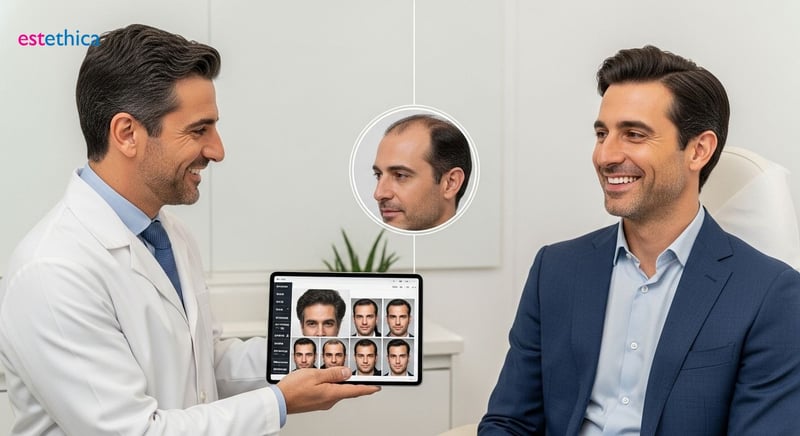Hair Transplant: Your Guide to Hair Restoration & Loss Solutions
Explore advanced hair transplant and hair restoration techniques as part of plastic surgery, addressing hair loss treatment with options like FUE and FUT. Understand candidate suitability, cost factors, and how to choose a skilled surgeon for optimal results.
Understanding Hair Transplant: What It Is and Who Is a Good Candidate
Hair transplantation is a sophisticated surgical procedure designed to address permanent hair thinning and baldness. At its core, it involves the meticulous relocation of hair follicles from areas of the scalp where hair is abundant – typically the sides and back, known as the donor area – to regions experiencing hair loss. This process is significantly enhanced by the expertise of plastic surgery, which ensures precision, an artistic approach to recreating a natural-looking hairline, and optimal density. The ultimate aim is to achieve a seamless integration of transplanted hair, making it virtually indistinguishable from the hair that was always there. This technique is a cornerstone of modern hair restoration, offering a lasting solution for many individuals.
What is a Hair Transplant Procedure?
The science behind a hair transplant lies in the genetic resilience of hair follicles in the donor areas. These follicles are resistant to the hormones that cause pattern baldness. During the procedure, these follicles are carefully extracted, either individually (Follicular Unit Extraction - FUE) or in small strips (Follicular Unit Transplantation - FUT). They are then meticulously prepared and implanted into the recipient sites, where hair loss has occurred. The surgeon's skill is paramount in determining the angle, depth, and density of implantation, crucial factors for achieving a natural and aesthetically pleasing outcome. This procedure requires a keen eye for detail, similar to the precision needed in other cosmetic procedures, such as those discussed in Understanding Gynecomastia: Your Guide to Male Breast Reduction, where careful sculpting is essential.
Who Is a Good Candidate for Hair Transplantation?
The ideal candidate for a hair transplant is typically someone experiencing progressive, permanent hair loss, most commonly male or female pattern baldness. A crucial requirement is having a sufficient supply of healthy, robust donor hair. The individual should also be in good general health, capable of undergoing a surgical procedure and a recovery period. It's vital for potential candidates to have realistic expectations about the results. While a hair transplant can dramatically improve the appearance of thinning hair and bald spots, it's not about achieving the exact thickness of youth overnight. The focus is on creating a natural, aesthetically pleasing density that complements the individual's facial features. A comprehensive consultation with a qualified plastic surgeon is an indispensable first step. This consultation allows for a thorough assessment of candidacy, a discussion of potential outcomes, and a clear understanding of the recovery process. Factors such as hair texture, color, curl, and the specific pattern and extent of hair loss are all meticulously evaluated to devise the most effective hair restoration strategy for each person.
This form of hair loss treatment offers a viable path to regaining confidence for many. For those exploring different avenues of hair loss treatment, understanding the process and suitability is key. The goal is to achieve effective and satisfying results through expert application of the hair transplant technique, ensuring the best possible outcome for long-term hair restoration.

Exploring Treatment Options: FUE vs. FUT Hair Transplants
When considering surgical interventions for hair regrowth, two primary techniques have emerged as the gold standard: Follicular Unit Transplantation (FUT) and Follicular Unit Extraction (FUE). Both are sophisticated plastic surgery procedures designed to restore a natural-looking hairline and density, but they diverge significantly in their graft harvesting methodology. Understanding these differences is crucial for making an informed decision about your hair restoration journey.
The Strip Method: FUT Explained
Follicular Unit Transplantation, commonly known as the FUT or strip method, involves the precise removal of a thin, linear strip of scalp from a donor area, typically the back of the head where hair is genetically resistant to thinning. This harvested strip is then meticulously dissected under high magnification by skilled technicians, separating individual follicular units – the natural groupings of one to four hairs. These units are subsequently implanted into the meticulously prepared recipient sites on the scalp. A key characteristic of FUT is the creation of a single, linear scar in the donor region. While this scar is typically well-hidden by surrounding hair when styled appropriately, it is a permanent mark. FUT can be an excellent option for patients seeking a significant number of grafts in a single session, often preferred for extensive hair loss coverage.
Direct Extraction: The FUE Approach
In contrast, Follicular Unit Extraction (FUE) bypasses the strip harvesting process. Instead, FUE involves the direct extraction of individual follicular units from the donor area using specialized micro-punches, usually measuring less than 1 millimeter in diameter. This technique results in numerous tiny, scattered scars that are generally imperceptible, even with very short hairstyles. FUE is often favored by patients who prefer minimal scarring, desire short haircuts, or require smaller, more targeted transplant sessions. It can also be a good choice for revising scars from previous procedures or for those with limited donor hair who need a conservative approach. Both FUE and FUT are effective hair transplant methods, and the choice between them hinges on various factors including your specific hair loss pattern, the density of your donor hair, your desired aesthetic outcome, and the expert recommendation of your plastic surgeon. A thorough consultation is paramount for determining the most suitable hair loss treatment for your unique circumstances. For those interested in complementary cosmetic procedures, exploring options like Rhinoplasty: Expert Nose Surgery for Ideal Nasal Reshaping can offer a comprehensive approach to aesthetic enhancement.
Hair Transplant Cost: Factors Influencing Price and Budgeting
The financial investment for a hair transplant can differ considerably, influenced by a variety of pivotal elements. As a sophisticated plastic surgery procedure, the pricing accurately reflects the inherent complexity, the level of skill required, and the overall scope of the intervention. Understanding these components is essential for effective budgeting and setting realistic expectations for your hair restoration journey.
Key Factors Affecting Your Hair Transplant Investment
The number of grafts needed is a primary determinant of the overall expense. More extensive thinning or baldness, which necessitates the transplantation of a larger quantity of follicular units, will naturally result in a higher cost. Similarly, the chosen surgical technique plays a significant role. For instance, Follicular Unit Extraction (FUE) procedures, often considered more labor-intensive due to their meticulous nature, tend to be priced higher than Follicular Unit Transplantation (FUT).
The expertise and reputation of the plastic surgeon and the clinic also contribute to the overall investment. Highly acclaimed surgeons with a documented history of successful outcomes in hair restoration procedures may command higher fees, reflecting their specialized knowledge and experience. Furthermore, the geographical location where the procedure is performed can influence costs, with treatments in major urban centers often being more expensive than those in smaller towns. Finally, the advanced technology and state-of-the-art equipment utilized by a clinic can also impact the final price.
Budgeting for Your Procedure
When planning your budget for hair restoration, it is crucial to obtain a comprehensive breakdown of all associated costs from your prospective clinic. This ensures transparency and a clear understanding of what is included in the quoted price. Always inquire about pre-operative consultations, the procedure itself, post-operative care, and any necessary medications or follow-up appointments.
It's important to remember that investing in high-quality expertise and a reputable clinic is paramount for achieving desirable and natural-looking results from your hair loss treatment. While cost is a consideration, prioritizing the skill of your surgeon and the clinic's standards will yield the best long-term outcomes. For those interested in enhancing overall facial aesthetics, exploring complementary procedures like those discussed in Facelift & Facial Rejuvenation: Renew Your Youthful Appearance might also be of interest, although these are distinct from hair transplantation.

Choosing the Best Hair Transplant Clinic and Surgeon for Optimal Results
Selecting the right plastic surgeon and clinic is arguably the most critical step in achieving successful hair restoration. A hair transplant is a significant procedure, and the skill of the practitioner directly impacts the aesthetic outcome and the naturalness of the results. It's essential to approach this decision with careful consideration and thorough research to ensure you achieve the best possible outcome.
Credentials and Experience: The Foundation of Trust
When beginning your search, prioritize board-certified plastic surgeons who specialize in hair restoration. Their credentials and years of experience are vital indicators of their expertise in this specific field. Don't be afraid to inquire about their training, the number of procedures they perform regularly, and their specific techniques. A surgeon deeply entrenched in the practice of follicular unit transplantation (FUT) or follicular unit extraction (FUE) will possess a nuanced understanding of density, angulation, and natural hairline design. Examining a surgeon's portfolio of before-and-after photos is paramount. These visual records offer tangible proof of their aesthetic sense and the quality of their surgical work. Look for consistency in results, a natural-looking hairline, and a good density of transplanted hair. Patient testimonials and online reviews can also provide invaluable insights into the experiences of others who have undergone similar procedures with the clinic and surgeon you are considering. These personal accounts can highlight aspects like patient care, communication, and overall satisfaction.
The Consultation and Beyond: Ensuring a Personalized Approach
The consultation phase is your opportunity to assess the surgeon and clinic on a personal level. Pay close attention to the surgeon's communication style. Do they listen attentively to your concerns? Are they transparent and willing to answer all your questions comprehensively? A reputable practitioner will dedicate time to understanding your specific situation, including the cause of your hair loss and your desired outcome. They should propose a personalized treatment plan tailored to your individual needs and expectations. During this meeting, a detailed explanation of the hair transplant procedure, including potential risks, the expected recovery process, and realistic outcomes, should be provided. It is also wise to understand their post-operative care instructions and follow-up protocols. If you feel uncertain or rushed, don't hesitate to seek second opinions from other qualified professionals. Much like exploring options for procedures such as Vaginal Rejuvenation: Restore Confidence and Intimacy, where thorough consultation is key, so too is it essential for effective hair loss treatment. Ultimately, choosing a clinic that prioritizes patient care, demonstrates a high level of skill, and is committed to delivering exceptional results will ensure your hair transplant journey is a positive and rewarding one, leading to improved confidence and satisfaction.

Precision Hair Transplantation: FUE and FUT Techniques for Natural Regrowth
Our approach to hair transplantation utilizes advanced techniques like Follicular Unit Extraction (FUE) and Follicular Unit Transplantation (FUT) to meticulously relocate hair follicles. This ensures precision in recreating a natural-looking hairline and achieving optimal hair density, addressing permanent hair thinning and baldness effectively.
We focus on the genetic resilience of hair follicles from abundant donor areas, carefully moving them to regions experiencing hair loss. This process, enhanced by plastic surgery expertise, guarantees an artistic and precise outcome for restorative hair procedures.
Our team comprises highly skilled professionals with extensive experience in surgical hair restoration and cosmetic hair surgery. We are dedicated to mastering the latest advancements in hair follicle movement and regenerative hair therapy to provide superior hair thinning solutions.
The selection of the best hair transplant clinic is paramount, and our credentials reflect a commitment to excellence. We prioritize a personalized approach, ensuring each patient's journey towards natural hair regrowth is managed with the utmost care and professional integrity.
Expert Hair Restoration Consultation for Optimal Results
We emphasize transparent and detailed consultations to ensure patients understand every aspect of their hair transplant procedure. This includes clear explanations of FUE vs. FUT techniques and realistic expectations for hair regrowth.
Our clinics are equipped with state-of-the-art technology to support advanced hair procedures. We ensure that the scalp surgery process is as comfortable and effective as possible, prioritizing patient safety and well-being throughout their treatment.
Patients seeking the best hair transplant clinic consistently find our approach reassuring, with a focus on achieving natural-looking results that accurately reflect the desired outcome. We are committed to delivering clear and understandable visuals of the procedures and their results.
Our success is measured by the satisfaction and restored confidence of our patients. We are proud to offer hair restoration solutions that genuinely transform lives, providing a clear pathway to regaining a fuller, more youthful head of hair.